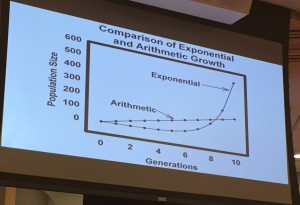This is a live blog post from the Ark Best Practices & Management Strategies for Law Firm Library, Research & Information Services conference in NYC. The topic of this session is “Surprise! How Our Unplanned Future Can Inform Today’s Decisions”. The presenter is John Alber, Practical Futurist (and retired Bryan Cave tech partner).
[This is live, posted as a session ends. Please forgive typos and any error in understanding.]
Topics that John will cover today include:
- Surprise inherent in tech change
- Understand why we have this surprise
- “Posture of mind” individuals can adopt in times of change
- Design thinking (from Stanford Design School)
The posture you need to handle the surprise of tech…. When the first mobile phone came out, bigger than several bricks, who could have predicted smart phones, selfie sticks, and pervasive video takes. When ARPANET was invented, who anticipated the the 10B node network the Internet is today (much less the soon-to-be 10T node network). When the first transistor was invented, who could have predicted all the silicon on a chip and DNA on a chip for computing. From early, clunky printers, who could have anticipated 3-D printing that is rapidly becoming ubiquitous.
Why can’t we see these developments?
- Exponential growth
- Democratization
- Convergence
Exponential Growth. Humans are wired to understand liner growth but not exponential growth:
Moore’s law is an example of exponential growth (doubling of computer power every 18 months). When we are in the flat part of an exponential growth curve, it seems linear and we don’t notice. It’s only when we get to the “knee”, where the curve goes up sharply, that we notice.
Many technologies grow exponentially: bandwidth, maker tech, mobile devices, sensors, network nodes.
Democtratization. At the knee of the exponential curve, markets are often disrupted. Sequence is from democratize, demonetize, dematerialize, and then disruptive. As more and more people have tech and as the price keeps dropping, many previously paid services become free or near-free. Eventually everyone gets the tech. Cites as example very fast recent growth of mobile handsets today in Africa.
Convergence. Tendency of disparate technologies to come together for new or combined functionality. Morgan Stanley notes that market share of converged technologies keeps increasing, e.g., mobile phones.
Apply to Access to Justice (A2J): 90% of legal problems remain unaddressed in the US today. Apply “design thinking” to solve the problem. To solve the problem, we must address Fees, delay, complexity, scarcity, and fairness. With advancing tech, we need to deploy artificial intelligence (AI).
Empathy. What does it look like to apply design thinking to apply AI to solve the access to justice problem. You need to apply empathy for the solution. Let’s look at how this works for contracts. John points out that most people cannot understand most contracts.
Smart Contracts. What if contracts were self-enforcing and we didn’t need all the paperwork. Vending machines are a simple example of a self-enforcing contract. Using blockchain technology (which underlies Bitcoin), is the answer. It is a trust-less ledger; it does not require intermediaries. It works by encrypting every transaction at multiple nodes on network. Example: if you pay for a car with a loan and you stop paying, the car can stop working. [RF comment: some cars purchased today with certain loans have interlock devices. When lessees stop paying, the lessor can remotely disable the car. This have given rise to serious safety and other issues. In my view, this illustrates that tech can lead to good or bad. This not blockchain but it reflects an issue we need to consider and avoid.]
Applying this Framework to Large Law Firms. Lawyers use tech in their personal lives. The failing may be among firms as institutions in failing to empathize with how people – lawyers – work. Empathy here means trying to understand at a deep level how lawyers work and what clients want and need.
The Net of it All. We cannot anticipate the pathers of exponential growth. You can expect democratization and demonetization. You can expect convergence. Shift attention from answer tech provides to the question you need to ask. Asking the right question often means really understanding what your real business is (example: Kodak thinking it was in the film business). You must empathetically locate inefficiency and expunge it ruthlessly.
Archives
Blog Categories
- Alternative Legal Provider (44)
- Artificial Intelligence (AI) (57)
- Bar Regulation (13)
- Best Practices (39)
- Big Data and Data Science (14)
- Blockchain (10)
- Bloomberg Biz of Law Summit – Live (6)
- Business Intelligence (21)
- Contract Management (21)
- Cool Legal Conferences (13)
- COVID-19 (11)
- Design (5)
- Do Less Law (40)
- eDiscovery and Litigation Support (165)
- Experience Management (12)
- Extranets (11)
- General (194)
- Innovation and Change Management (188)
- Interesting Technology (105)
- Knowledge Management (229)
- Law Department Management (20)
- Law Departments / Client Service (120)
- Law Factory v. Bet the Farm (30)
- Law Firm Service Delivery (128)
- Law Firm Staffing (27)
- Law Libraries (6)
- Legal market survey featured (6)
- Legal Process Improvement (27)
- Legal Project Management (26)
- Legal Secretaries – Their Future (17)
- Legal Tech Start-Ups (18)
- Litigation Finance (5)
- Low Cost Law Firm Centers (22)
- Management and Technology (179)
- Notices re this Blog (10)
- Online Legal Services (64)
- Outsourcing (141)
- Personal Productivity (40)
- Roundup (58)
- Structure of Legal Business (2)
- Supplier News (13)
- Visual Intelligence (14)

